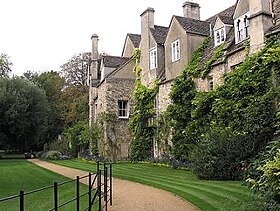Gloucester College, Oxford
| Gloucester College | |
|---|---|
| University of Oxford | |
 | |
| Location | Present day Worcester Street |
| Coordinates | 51°45′18″N 1°15′49″W / 51.75497°N 1.26370°W |
| Established | 1283 |
| Closed | 1542 (annexed to St John's) 1714 (refounded as Worcester College) |
| Named for | St. Peter Abbey, Gloucester |
| Previous names | Gloucester Hall (1542) |
| Principal | see below |
| Map | |
Gloucester College, Oxford, was a Benedictine institution of the University of Oxford in Oxford, England, from the late 13th century until the Dissolution of the monasteries in the 16th century. It was never a typical college of the University, in that there was an internal division in the college, by staircase units, into parts where the monasteries sending monks had effective authority.[1] The overall head was a Prior.[2]
It later became Gloucester Hall, an annexe of St John's College and was again refounded in 1714 as Worcester College by Sir Thomas Cookes.
History
The initial foundation was from 1283. John Giffard gave a house, in Stockwell Street, Oxford.[3] There was early friction with the local Carmelites.[4] This was a donation to the Benedictines of the province of Canterbury. Control of the 13 places for monks fell to the abbey of St. Peter, Gloucester.[5] The first prior was Henry de Heliun.
Pope Benedict XII in 1337 laid down, in the bull Pastor bonus, that 5% of Benedictine monks should be university students.[6] But from the middle of the fourteenth century onwards there was an alternative, at the University of Cambridge.[7] There were also the Benedictine Durham College, Oxford, and Canterbury College, Oxford. Even though the catchment area after 1337 included the Province of York, numbers of students were never high, one reason being the cost of living in Oxford (which the home monastery had to meet). After the Black Death, Gloucester College was closed for a time. In 1537 it was found to have 32 students.[8]
At the Dissolution the property passed to the English Crown, then to the Bishop of Oxford in 1542,[9] who sold it to Sir Thomas White. White was the founder of St John's College, Oxford, and Gloucester Hall, as it then became, was treated as an Annexe to St John's College.
The penultimate Principal of Gloucester Hall, Benjamin Woodroffe, established a 'Greek College' for Greek Orthodox students to come to Oxford, part of a scheme to make ecumenical links with the Church of England.[10] This was active from 1699 to 1705, although only 15 Greeks are recorded as members.
The status of Gloucester Hall changed in the 18th century, when it was refounded in 1714 by Sir Thomas Cookes as Worcester College, Oxford. Oxford's Gloucester Green, which was opposite the old College, and the Gloucester House building within the current college preserve the name.
Principals of Gloucester Hall
- 1560–1561 William Stocke
- 1561–1563 Richard Eden
- 1563–1564 Thomas Palmer
- 1564–1576 William Stocke
- 1576–1580 Henry Russell
- 1580–1581 Christopher Bagshawe
- 1581–1593 John Delabere
- 1593–1626 John Hawley
- 1626–1647 Degory Wheare
- 1647–1647 John Maplett
- 1647–1660 Tobias Garbrand
- 1660–1662 John Maplett
- 1662–1692 Byrom Eaton
- 1692–1711 Benjamin Woodroffe
- 1712–1714 Richard Blechynden.[11]
Alumni
Those who studied at the college and hall include:
Gloucester College (1283–1542)
- Henry Bradshaw
- Adam Easton
- John Feckenham
- John Lydgate (supposed)
Gloucester Hall (1542–1714)
Notes and references
- ^ David Knowles, The Religious Orders in England vol. II (1955) p.14 calls it 'something of a patchwork' and (p.17) 'a loose confederation of small groups rather than a college.'
- ^ Appointed by the Abbot of Malmesbury, but there was a regent master appointed by the provincial Benedictine presidents. (Knowles p.14)
- ^ Stockwell Street no longer exists, but it "ran northwards from the Castle along the line of the present Worcester and Walton Streets" (Nicholas de Stockwell, Oxford History).
- ^ This persisted into the 16th century.The House of White Friars, Victoria County History, 1907.
- ^ Houses of Benedictine monks: Gloucester College, Oxford', A History of the County of Oxford: Volume 2 (1907), pp. 70–71 Date accessed: 23 January 2007.
- ^ Knowles p.15.
- ^ Knowles p.17.
- ^ Leach, Arthur Francis (1911). . In Chisholm, Hugh (ed.). Encyclopædia Britannica. Vol. 24 (11th ed.). Cambridge University Press. p. 365.
- ^ Jericho Echo Online.
- ^ Template:Cite article
- ^ 'Gloucester Hall and Worcester College', A History of the County of Oxford: Volume 3: The University of Oxford (1954), pp. 298-309. URL: http://www.british-history.ac.uk/report.aspx?compid=63890 Date accessed: 17 April 2012.



